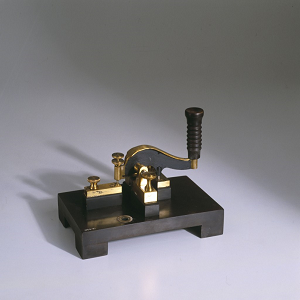Doctor Curmudgeon … . .-. — —
By Diane Batshaw Eisman, M.D. FAAP Doctor Eisman is in Family Practice in Aventura, Florida with her partner, Dr. Eugene Eisman, an internist/cardiologist
… . .-. — —
This is not an eye test. Your eyes are not deceiving you. Those dots and dashes are in Morse code.
It stands for SERMO, of course.
Years ago, before most of us were born, people communicated face to face, or you could send a letter—maybe a smoke signal was quicker. But along came Morse with a method of fast long distance transmission.
Samuel Finley Breese Morse was a famous painter and inventor. Morse’s research began when a friend introduced him to the work of a physicist, Joseph Henry. Search Britannica: “The powerful electromagnets that Henry had devised allowed Morse to send messages over 16 km (10 miles) of wire.”
Alfred Vail was a mechanical engineer who developed the electrical telegraph system. With the help of Vail, Morse was able to use electrical pulses and the silence between the pulses to develop a code.
On May 24, 1844, a message using Morse code was transmitted from Washington, D.C. to Baltimore. This was the first time that messages could be communicated instantaneously. Vail was waiting in Baltimore. He received the message and sent it right back to Morse successfully.
What is Morse code anyway? It’s a system of communicating over telegraph wires. No spoken words. Just a bunch of long and short sounds—dots and dashes. Each letter of the Latin alphabet has a group of dots and dashes assigned to it.
They’re called “dits” and dahs” because that is what they sound like. And a “dah” is as long as three “dits.” The code was constructed based on how often a letter was used in English. “E” is one of the most commonly used letters and it gets the single “dot” for its representation.
Morse code can be sent by means other than electrical pulses. It was not uncommon during World War II to see soldiers of the Signal Corps walking down the street holding hands. They were practicing their Morse code. Short squeezes for a dot and long ones for a dash.
On May 2, 1966, Commander Jeremiah Denton, a prisoner held by the North Vietnamese, was interviewed on Japanese television for propaganda. During the interview, He blinked out “T-O-R-T-U-R-E” in Morse code to tell intelligence officers that POWs were suffering abuse.
Don’t discount the use of Morse code today. You can even set up your android or IPhone to accept it.
… .. –. -. .. -. –. / — ..-. ..-.
(Editor’s note from Galahad, Doctor Curmudgeon’s Siberian Husky cousin: I am not responsible for errors made in the actual representation of dots and dashes used by my cousin. But I believe that the above message says “S-I-G-N-I-N-G O-F-F)
THE PHOTO OF MORSE KEY ABOUT 1850-1859 FROM THE SCIENCE MUSEUM /SSPL
Dr. Curmudgeon suggests “Bitter Medicine”, Dr. Eugene Eisman’s story of his experiences–from the humorous to the intense—as a young army doctor serving in the Vietnam War.
Bitter Medicine by Eugene H. Eisman, M.D. –on Amazon
Doctor Curmudgeon® is Diane Batshaw Eisman, M.D., a physician-satirist. This column originally appeared on SERMO, the leading global social network for doctors.
SERMO www.sermo.com
Click Here to Order Boxing Interviews Of A Lifetime By “Bad” Brad Berkwitt


